Estimated Reading time

10 Mins
2024 in Review: 24 Good News Stories from First Nations
Over the past year, First Nations have gained significant recognition for managing their lands, revitalizing their languages and cultures, and fostering sustainable, community-driven economies.
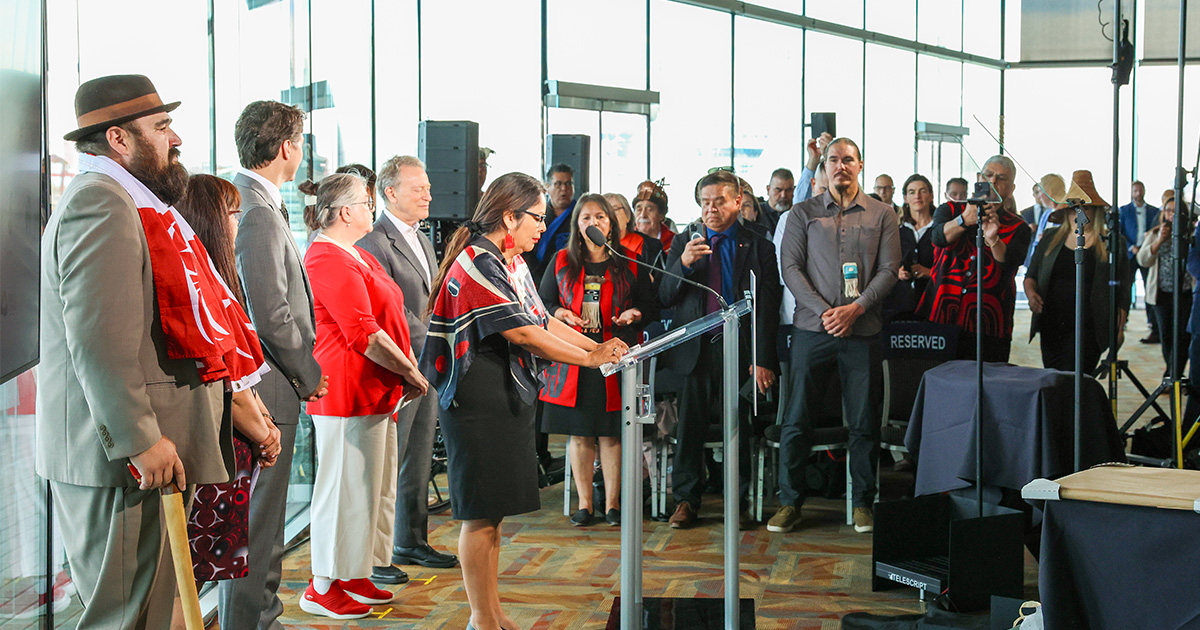
First Nations in the Great Bear Rainforest and Haida Gwaii made headlines in 2024 for their groundbreaking achievements in environmental stewardship, economic development, sustainable energy, and cultural revitalization.
This year marked significant progress in Indigenous rights and conservation. Nations advanced treaty and title agreements, declared new protected areas, and invested in coastal communities and economic development.
The announcement of the Great Bear Sea project finance for permanence further strengthened conservation efforts, and Indigenous languages found fresh expression through innovative mediums like graphic novels and music albums, ensuring cultural preservation for generations to come.
In the sections below, our team has rounded up 24 good news stories from 2024 across six themes:
- Conservation Finance
- Stewardship and Conservation
- Governance
- Sustainable Energy
- Economic Development
- Arts and Culture
CONSERVATION FINANCE
1. Through the Great Bear Sea PFP, First Nations secured $335 million for marine stewardship, coastal economic development
On June 25, 17 First Nations, along with Canada, British Columbia, and private funders, announced the closing of the Great Bear Sea project finance for permanence (PFP) initiative, securing $335 million for marine conservation and sustainable economic development. With PFP funding, First Nations and their partners will advance work on a Marine Protected Area (MPA) Network in the region and continue collaborating on marine use planning through the Marine Plan Partnership (MaPP).
The Great Bear Sea PFP builds on decades of collaboration, leveraging government, philanthropic, and private investments to ensure long-term conservation and prosperity on the coast.
“The coastal First Nations identified a need for sustainable funding that puts us in the driver’s seat. With the Project Finance for Permanence initiative, we’ve been having key conversations around what the dollar needs are to complete this work and to make sure it’s sustainable over the years.”
– Danielle Shaw, elected Chief Councillor, Wuikinuxv Nation (Great Bear Sea PFP Booklet)

2. Indigenous Nations in the Northwest Territories launched ‘Our Land for the Future’ fund, modelled after the Great Bear Rainforest PFP
In November, 22 Indigenous governments signed a landmark agreement with the Government of Canada, the Government of the Northwest Territories, and private donors to establish a new $375-million PFP initiative: Our Land for the Future, which aims to protect 38 million hectares of boreal forest and wetlands. This new fund builds on the model first trialed in the Great Bear Rainforest and will support Indigenous-led conservation, stewardship, and economic development for at least a decade.
3. Marine Plan Partnership partners with Coast Funds
This year, Coast Funds signed an agreement to provide financial and administrative services for the Marine Plan Partnership for the North Pacific Coast (MaPP), which includes 17 First Nations and British Columbia. Through the new agreement, Coast Funds will support MaPP with fund administration, investment management, and financial reporting, helping the MaPP team to focus on marine stewardship and planning. The agreement also integrates MaPP’s financial administration with funding delivered through the Great Bear Sea PFP.
4. New research shared on conservation finance tools
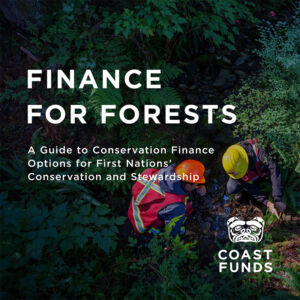 Following community engagement with First Nations and partners, Coast Funds released Finance for Forests, a guide to financing First Nations’ conservation, stewardship, and Guardian programs. The report highlights opportunities for First Nations to access and develop conservation financing and evaluates how different financing options can support community interests.
Following community engagement with First Nations and partners, Coast Funds released Finance for Forests, a guide to financing First Nations’ conservation, stewardship, and Guardian programs. The report highlights opportunities for First Nations to access and develop conservation financing and evaluates how different financing options can support community interests.
GOVERNANCE
5. Haida Nation achieved historic Title recognition
In April, the Haida Nation and the Province of British Columbia reached a groundbreaking milestone with the Gaayhllxid • Gíihlagalgang Rising Tide Haida Title Lands Agreement. This marks the first bilateral agreement in Canada to formally recognize Indigenous title outside of the treaty process. The agreement, supported by 95 per cent of Haida citizens, outlines a collaborative governance framework between the Haida Nation and BC to manage lands and waters on Haida Gwaii. At the federal level, lawmakers worked to pass Bill S-16, which recognizes the Council of the Haida Nation as the government of the Haida Nation.

6. K’ómoks, Kitsumkalum, and Kitselas Nations advanced treaty agreements
This summer, three First Nations on the coast reached significant treaty milestones: Kitselas First Nation, Kitsumkalum First Nation, and K’ómoks First Nation each initialled treaty agreements with Canada and British Columbia.
STEWARDSHIP AND CONSERVATION
7. Indigenous Conservation Forum highlighted Indigenous leadership on IPCAs
This fall, representatives from more than 70 Indigenous Nations gathered for the inaugural Indigenous Conservation Forum, where participants shared knowledge and celebrated achievements in conservation and stewardship. Of seven presented Indigenous governments included the Haida Nation, Kitasoo and Mamalilikulla First Nations. Event organizers hosted sessions on governance of protected areas, community readiness and conservation finance.
Presenters also highlighted the critical role of Indigenous leadership in achieving global conservation goals like protecting 30 per cent of Earth’s land and water by 2030 under the Kunming-Montreal Global Biodiversity Framework.

8. Nuxalk Nation celebrated the largest return of sputc eulachon in a generation
Nuxalk citizens celebrated the largest return of sputc eulachon in over two decades, marking a significant victory for the community and the species. Sputc are a vital cultural and nutritional resource for the Nuxalk and, in Nuxalk tradition, their return to the Bella Coola estuary marks the end of winter and the beginning of spring.
9. Kus-kus-sum and Nawalakw won big at the Land Awards Gala
This summer, the Real Estate Foundation of BC presented Land Awards for Kus-kus-sum, an ecological restoration project supported by K’ómoks First Nation, and the Nawalakw Community Farm, a Musga’makw Dzawada̱’enux̱w project. The awards recognized the project teams for their leadership in sustainable land use.
10. Indigenous Protected and Conserved Areas and Marine Protected Areas

First Nations in British Columbia are making significant strides in establishing new IPCAs and MPAs to manage sensitive ecosystems within their territories. In 2024 this included:
- Wei Wai Kum First Nation declared a new IPCA at Homayno, in Loughborough Inlet.
- Mamalilikulla First Nation signed an agreement with British Columbia to collaboratively manage the Gwa̱xdlala/Nala̱xdlala Lull Bay/Hoeya Sound IPCA and Mamalilikulla Marine Refuge.
- Haida Nation, Pacheedaht First Nation, Nuu-Chah-Nulth Tribal Council, and Quatsino First Nation partnered with the Government of Canada to create the Tang.ɢwan-ḥačxʷiqak-Tsig̱is MPA.
- Kitasoo Xai’xais Nation’s Gitdisdzu Lugyeks Kitasu Bay MPA received a Blue Park Award.
These efforts and awards reflect the continued leadership of Indigenous communities in marine and coastal conservation.
11. Ahousaht and Tla-o-qui-aht Nations secured historic protections in Clayoquot Sound
In June, Ahousaht and Tla-o-qui-aht First Nations, in partnership with the provincial and federal governments, announced the protection of 76,000 hectares of forested land in their territories. This historic move nearly doubles the old-growth forest protections in the region, which is renowned for its coastal temperate rainforests.
12. Kwiakah Centre for Excellence set to open in spring 2025
Kwiakah Nation is developing a Centre for Excellence to support research and stewardship activities in their newly-declared Special Forest Management Area (SFMA). The floating facility, set to open in 2025, includes an accommodation barge, a research lab, a float house for the Nation’s Guardian team, and a one-hectare test farm for kelp and seaweed, all anchored near Kwiakah’s Matsayno reserve. The Centre will host up to 16 scientists and staff.
“By creating the M̓ac̓inuxʷ SFMA, we are asserting our inherent responsibilities and creating an Indigenous-led conservation economy that will steward and heal our territory while allowing our people to thrive.”
– Kwiakah Chief Steven Dick (news release)
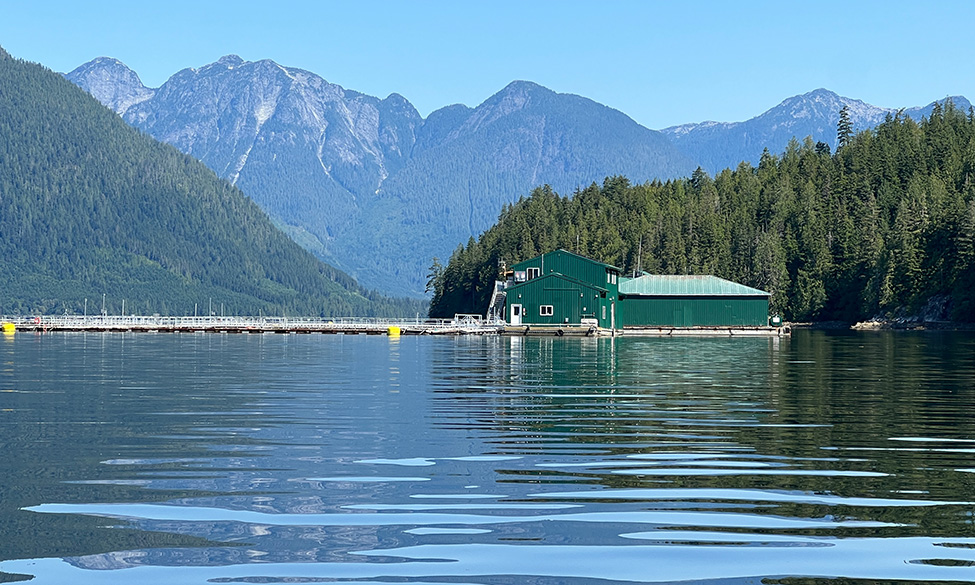
13. National Guardians Network
The National Guardians Network, launched in 2022, allocated $27.6 million for 80 First Nations’ Guardian initiatives. The Network reduced the funding turnaround time from six months to 60 days, improving accessibility and supporting Nations to focus their efforts on stewardship.
14. Bottom-contact fishing closed
The Kitasoo Xai’xais and Haíɫzaqv Nations worked with the Fisheries and Oceans Canada (DFO) to close bottom-contact fishing in q̓áuc̓íwísuxv Lophelia Reef, which contains rare, cold-water corals. q̓áuc̓íwísuxv is the most northern coral reef in the Pacific Ocean and, in 2022, Kitasoo Xai’xais, the Central Coast Indigenous Resource Alliance, and DFO conducted joint surveys to map the reef. While the area is remote and not widely fished, surveys found evidence of physical damage to the living coral – likely caused by bottom-contact fisheries.
SUSTAINABLE ENERGY
15. Ulkatcho First Nation broke ground on the largest off-grid solar project in Canada
Ulkatcho First Nation in Anahim Lake, BC, is constructing the largest off-grid solar project in Canada, which is anticipated to cut diesel use by 64 per cent—over 1.1 million litres annually. This $15.8 million initiative, supported by federal, provincial, and community funding, will deliver clean energy through a partnership with BC Hydro.
16. Haida Gwaii tested renewable energy potential
The Council of the Haida Nation is partnering with the University of Victoria to research renewable energy resources around Haida Gwaii. A floating light detection and ranging buoy is collecting data on wind, waves, and currents at G̲adsguusd North Beach until September 2025. The project is assessing marine resources like wave, tidal, and offshore wind energy to reduce the island’s dependence on diesel. Haida Gwaii’s unique geography offers promising potential for reliable renewable energy.
17. Gitga’at First Nation progressed on its plan for a hydroelectric facility
Gitga’at First Nation continued work on a hydroelectric facility, planned to open in 2026, that will meet 95 per cent of the community’s electricity needs for the next 40 years. The project, supported with $4 million from the Community Energy Diesel Reduction (CEDR) program, will help the community reduce its reliance on diesel, manage electricity costs, and increase its energy sovereignty.
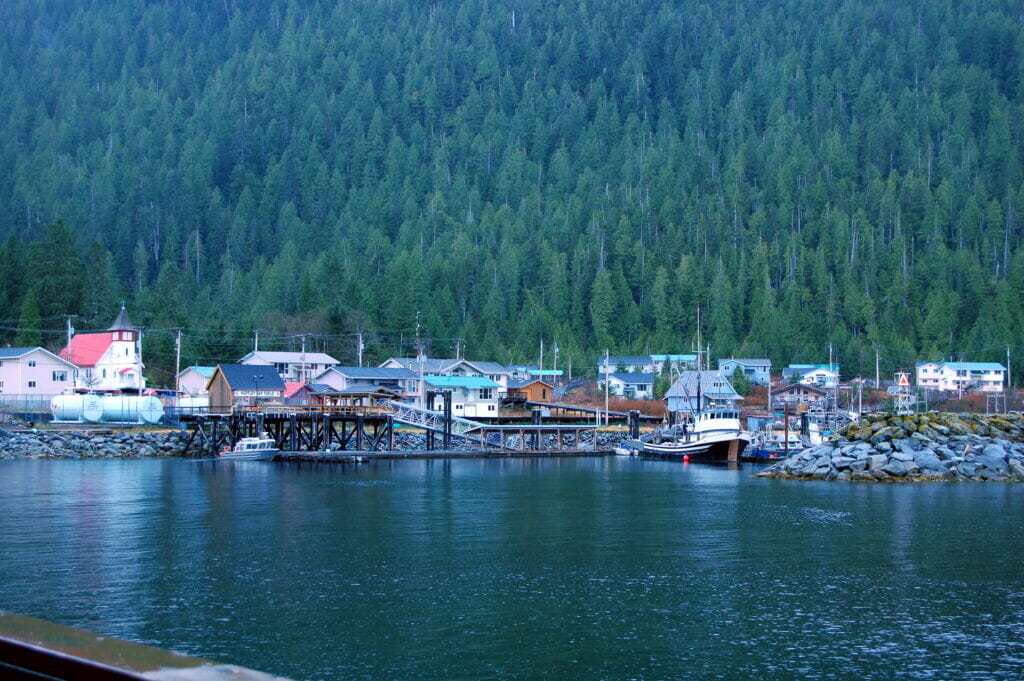
ECONOMIC DEVELOPMENT
18. We Wai Kai Nation opened the first Indigenous-owned Starbucks in Canada
Early this year, We Wai Kai Nation opened the first Starbucks café in Canada that’s licensed and operated by an Indigenous community. Located at Quinsam Crossing in Campbell River, the store is not only a business venture but a step toward greater economic self-sufficiency for the Nation. The store features We Wai Kai art – including a mural painted by Jessica Chickite – and has created over 20 jobs.
19. Gitxaała invested in energy-efficient renovations at the Crest Hotel
Since acquiring the Crest Hotel, Gitxaała Enterprises has renovated the property, installing new heat pumps in 80 rooms. In addition to the room renovations, Gitxaała Enterprises and the Crest’s management team have incorporated cultural elements into the hotel’s design, including space for local vendors. These improvements will ensure the hotel remains a welcoming hub for visitors to the region.

20. Metlakatla Wilderness Trail Reopened for Community, School Groups
Metlakatla First Nation revitalized a 20-kilometre wilderness trail within their traditional territory, enhancing opportunities for youth and members to engage in cultural harvesting practices and learn from Elders. For visitors, the trail offers not just a hike, but an opportunity to learn about Metlakatla’s cultural traditions and connection to the land.
ARTS AND CULTURE
21. This Place Is Who We Are earned prestigious BC historical writing award

Katherine Palmer Gordon’s book This Place Is Who We Are: Stories of Indigenous Leadership, Resilience, and Connection to Their Homelands earned second place at the 2024 BC Historical Writing Awards. The book, crafted in close partnership with First Nations leaders and community members, celebrates the strength of Indigenous communities in coastal British Columbia as they reconnect with their lands, cultures, and traditional practices.
22. Reviving tradition: Three Nations carve a historic canoe
The We Wai Kai, Wei Wai Kum, and K’ómoks Nations came together to carve a traditional 10-meter xwaxwana canoe from a windfall cedar, working with Na̲nwak̲olas Council to revitalize the traditional practice. The three carvers—Max Chickite (We Wai Kai), Junior Henderson (Wei Wai Kum), and Karver Everson (K’ómoks)—worked for two months to complete the canoe using traditional methods.
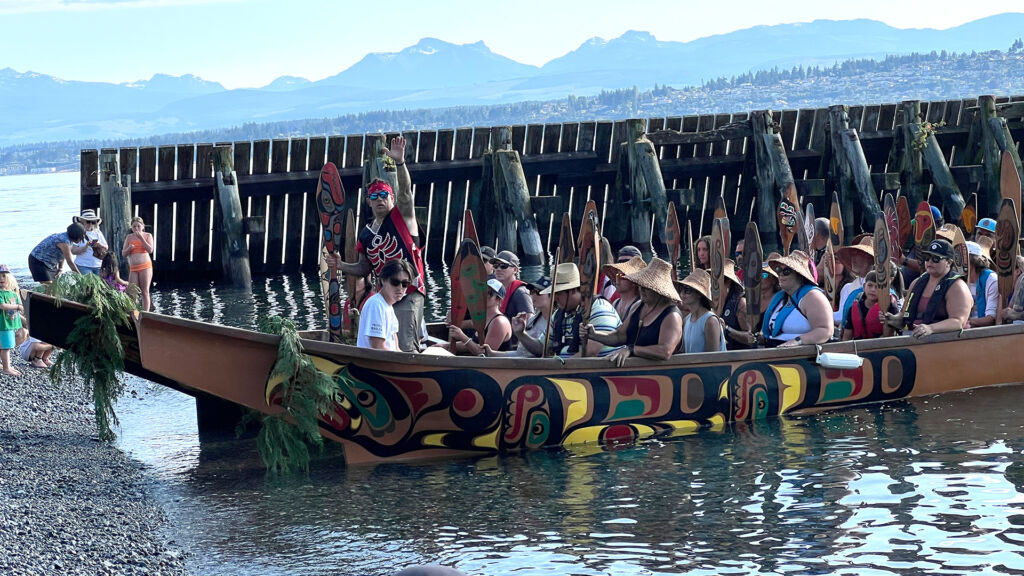
23. Nuxalk Radio released Nusximta: A groundbreaking album in the Nuxalk language
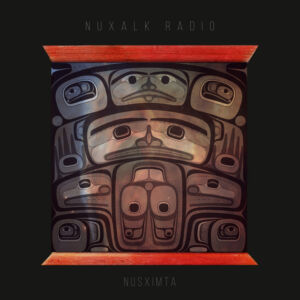 In June, Nuxalk Radio released Nusximta, the first full-length album entirely produced in the Nuxalk language. Celebrating the radio station’s 10-year anniversary, this album showcases the talents of Nuxalk community members aged eight to 67, blending traditional and contemporary music styles—from acapella and lullabies to hip-hop and EDM.
In June, Nuxalk Radio released Nusximta, the first full-length album entirely produced in the Nuxalk language. Celebrating the radio station’s 10-year anniversary, this album showcases the talents of Nuxalk community members aged eight to 67, blending traditional and contemporary music styles—from acapella and lullabies to hip-hop and EDM.
The album is available on major streaming platforms and serves as both an artistic achievement and a call for language revitalization.
24. Xwémalhkwu graphic novel brought Elder stories to life
In November, Xwémalhkwu (Homalco) First Nation released a graphic novel, Xwémalhkwu Hero Stories, that shares Elders’ stories with younger generations. To create the graphic novel, Nation members took inspiration from recordings made in the early 1990s, in which Elders shared memories of traditional life in the Nation’s territory.
Thank you for reading and reflecting on the incredible achievements of First Nations in the Great Bear Rainforest and Haida Gwaii in 2024. As we look ahead to 2025, we are excited to continue amplifying the stories of culture, leadership, and innovation shaping a sustainable future for coastal communities.
Stay connected for more updates and opportunities to engage in this vital work. You can follow along with our journey through our website, Talking Stick newsletter, and social media channels as we support First Nations in their ongoing efforts to lead environmental and cultural stewardship.
Follow us on: Facebook | LinkedIn | Instagram | Bluesky | Threads
More in this series: 2023 in Review | 2022 in Review
